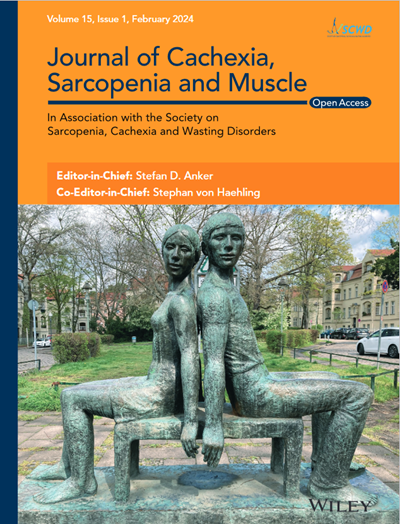Evidence for inefficient contraction and abnormal mitochondrial activity in sarcopenia using magnetic resonance spectroscopy
Abstract
Background
Mitochondrial dysfunction has been implicated in sarcopenia. 31P magnetic resonance spectroscopy (MRS) enables non-invasive measurement of adenosine triphosphate (ATP) synthesis rates to probe mitochondrial function. Here, we assessed muscle energetics in older sarcopenic and non-sarcopenic men and compared with muscle biopsy-derived markers of mitochondrial function.
Methods
Twenty Chinese men with sarcopenia (SARC, age = 73.1 ± 4.1 years) and 19 healthy aged and sex-matched controls (CON, age = 70.3 ± 4.2 years) underwent assessment of strength, physical performance, and magnetic resonance imaging. Concentrations of phosphocreatine (PCr), ATP and inorganic phosphate (Pi) as well as muscle pH were measured at rest and during an interleaved rest–exercise protocol to probe muscle mitochondrial function. Results were compared to biopsy-derived mitochondrial complex activity and expression to understand underlying metabolic perturbations.
Results
Despite matched muscle contractile power (strength/cross-sectional area), the ATP contractile cost was higher in SARC compared with CON (low-intensity exercise: 1.06 ± 0.59 vs. 0.57 ± 0.22, moderate: 0.93 ± 0.43 vs. 0.58 ± 0.68, high: 0.70 ± 0.57 vs. 0.43 ± 0.51 mmol L−1 min−1 bar−1 cm−2, P = 0.003, <0.0001 and <0.0001, respectively). Post-exercise mitochondrial oxidative synthesis rates (a marker of mitochondrial function) tended to be longer in SARC but did not reach significance (17.3 ± 6.4 vs. 14.6 ± 6.5 mmol L−1 min−1, P = 0.2). However, relative increases in end-exercise ADP in SARC (31.8 ± 9.9 vs. 24.0 ± 7.3 mmol L−1, P = 0.008) may have been a compensatory mechanism. Mitochondrial complex activity was found to be associated with exercise-induced drops in PCr [citrate synthetase activity (CS), Spearman correlation rho = −0.42, P = 0.03] and end-exercise ADP (complex III, rho = −0.52, P = 0.01; CS rho = −0.45, P = 0.02; SDH rho = −0.45, P = 0.03), with CS also being strongly associated with the PCr recovery rate following low intensity exercise (rho = −0.47, P = 0.02), and the cost of contraction at high intensity (rho = −0.54, P = 0.02). Interestingly, at high intensity, the fractional contribution of oxidative phosphorylation to exercise was correlated with activity in complex II (rho = 0.5, P = 0.03), CS (rho = 0.47, P = 0.02) and SDH (rho = 0.46, P = 0.03), linking increased mitochondrial complex activity with increased ability to generate energy through oxidative pathways.
Conclusions
This study used 31P MRS to assess ATP utilization and resynthesis in sarcopenic muscle and demonstrated abnormal increases in the energy cost during exercise and perturbed mitochondrial energetics in recovery. Associations between mitochondrial complex activity and the fractional contribution to energy requirement during exercise indicate increased ability to generate energy oxidatively in those with better mitochondrial complex activity.

 求助内容:
求助内容: 应助结果提醒方式:
应助结果提醒方式:


